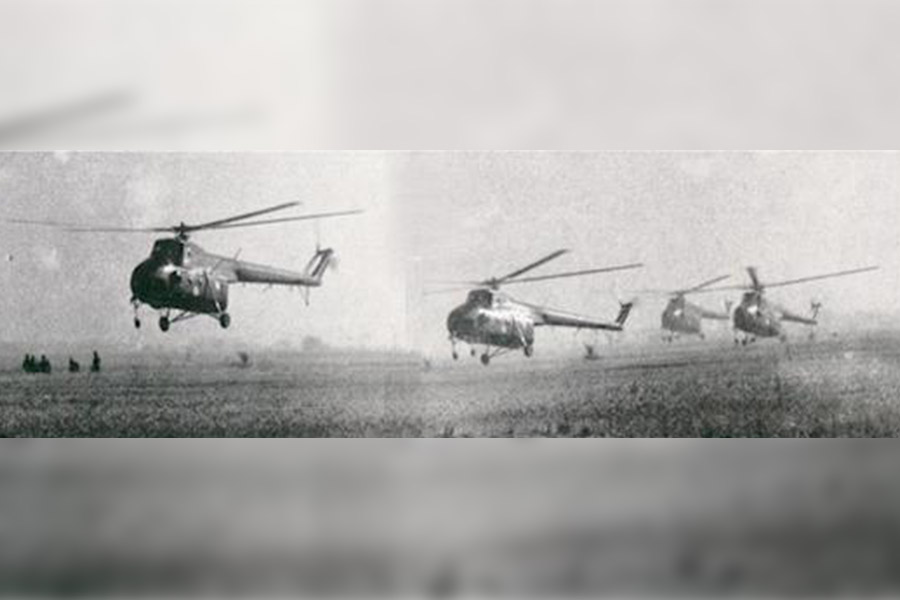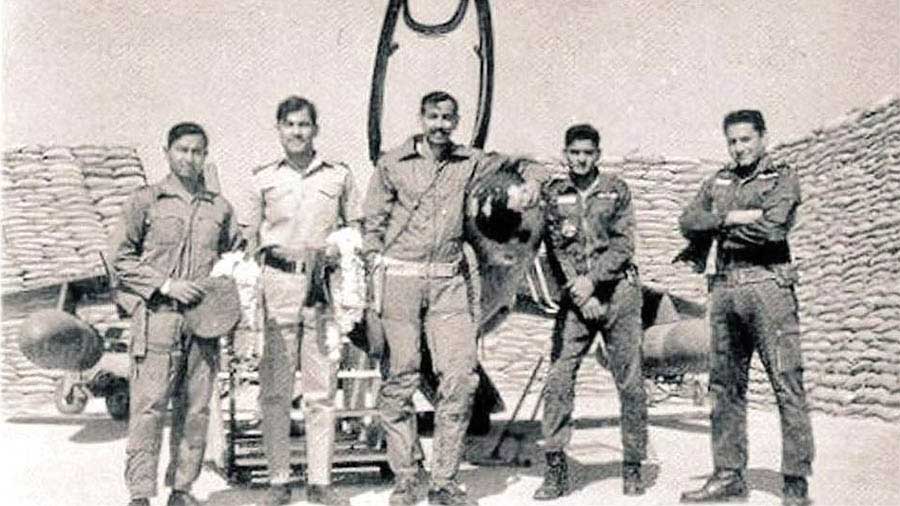Around this time 53 years ago, the Indian defence forces pulled off an audacious and daring operation that radically changed the flow of the Bangladesh Liberation War. This is the story of Operation Cactus Lily – a joint mission by the Indian Army and Indian Air Force.
Criss-crossed by mighty rivers, the terrain of East Pakistan presented a formidable challenge for the Indian Army. The thinktank, led by Army chief General Manekshaw, had correctly decided that the solution lay in a rapid advance to the capital Dacca – and avoid getting bogged down on the countryside. Conversely, the Pakistani defensive plan hedged on holding up and slowing down the Indian advances.

The Anderson bridge (present day), Bhairab Bazaar Wikimedia Commons
The 57th Mountain Division, under Major General Goncalves, had been tasked by IV Corps chief Lieutenant-General Sagat Singh to advance on Dacca from the north/north-east direction. On December 5, 1971, the 57th Mountain Division captured the first major target in their path: the town of Akhaura in Brahmanbaria upazilla. The defending Pakistani army started to withdraw, with plans for taking a defensive stance at Brahmanbaria.
However, the 57th Mountain Division had other plans. The 73 Mountain Brigade, one of the constituent brigades of the divisions, was tasked with spoiling the Pakistani plans. Aided by manoeuvring elements from the 311 Mountain Brigade, 73 Brigade forces started encircling Brahmanbaria. The Pakistani defensive elements blinked first, withdrawing from Brahmanbaria and settling down at the Ashuganj village on the eastern bank of the mighty Meghna. On the western bank was the heavily fortified Pakistani defensive position at Bhairab Bazaar. The bridge over the Meghna that connected the two positions extended for over 4,000 feet.
The bridge also offered the fastest ingress towards Dacca. Lieutenant-General Sagat Singh and Major General Goncalves decided it was a vital task to capture the Meghna bridge at Ashuganj. On the morning of December 9, 1971, the Pakistani 27 Infantry Brigade, the main defensive force, had turned Ashuganj into a fortified fortress. More troops and the divisional headquarters were stationed on the other bank at Bhairab Bazaar.

Lieutenant-General Sagat Singh Wikipedia
The 18 Rajput Regiment was the leading force that reached Ashuganj. They had moved rapidly and their artillery support, a group of PT-76 tanks from 63 Cavalry had failed to keep up with them. As they came in sight, unaware of the Pakistani strength, a fierce defensive attack was launched from the Pakistani side. With heavy artillery shelling creating havoc, the Rajputs had to put a halt on their access. While their tank support was yet to arrive, a friend was in the nearby skies.
The IAF Hunters from Kumbhirgram airbase swooped in, ready to strike when the Indian side was dealt a hard hand. A random fire from a Pakistani RCL gun struck the radio position, killing the radioman and injuring the forward air controller, FO Dalbir Singh. Although Dalbir quickly recovered, the radio set had been damaged and he had no way of connecting to the Hunters to pass on instructions for attack. With radio silence from the ground, the Hunters were forced to fly away.
The divisional headquarters on the west bank ordered to destroy a part of the eastern section of the bridge to prevent the Indians from accessing it. Meanwhile, 10 Bihar and the 63 Cavalry tanks had arrived at Ashuganj, providing much needed relief to the beleaguered Rajputs. A fierce battle now followed. With the eastern part of the bridge blown up, the Pakistani forces started retreating to the western bank on boats. 57 Mountain Division was stranded on the eastern bank.

India-Pakistan war 1971 Eastern Front Wikimedia Commons
But Lieutenant-General Sagat Singh had his sights set on Dacca and he was not ready to give up. Sagat Singh sought out Group Captain (later Air Vice Marshall) Chandan Singh, commander of the IAF Station Jorhat. The Singhs decided that the only way now was to airlift forces by helicopter, cross the Meghna and land on the western side, bypassing Bhairab Bazaar.
Just a few days ago, a similar operation had been carried out in Sylhet and Sagat Singh was convinced it would work again. Chandan Singh now begun work in earnest. IAF helicopters from Kailasahar base were forwarded to Brahmanbaria. Sagat Singh and Chandan Singh did an aerial recce of the west bank to ensure that no enemy forces were present near the landing zone. Local Mukti Bahini elements gave the all clear.
The helicopter-borne operations started at 0330 hours on December 9. An advance party flew out on an army Aloutte helicopter to the landing site at Raipura on the western bank to mark out the landing zone on the ground. On the eastern bank, Brahmanbaria Stadium became the boarding point. Soviet-made Mi4 helicopters of the Air Force were engaged for the task. Elements of 4 Guards were carried by the helicopters across the river and dropped at Raipura. With dusk descending, torches had been lit by the advance party, aided by Muktis, to guide the helicopters.
By the end of December 10, the IAF Mi-4s had carried out 57 sorties, depositing 647 troops and 8,200kg equipment at Raipura. At all times, the landing parties remained at risk of attack from the strong Pakistani hold-up at Bhairab Bazaar. Hunters of 17 Squadron from Kumbhirgram, frustrated during the Battle of Ashuganj, were requisitioned by 4 Corps headquarters to carry out attacks at the Pakistani position and thereby ensure no interference.

A section of amphibious tanks from 6 Cavalry had also crossed the Meghna Wikimedia Commons
19 Punjab Regiment forces moved further south from Ashuganj and crossed over in civilian boats with the Mukti Bahini elements providing vital logistical support. Once on the western bank, the Punjabis took positions around Bhairab Bazaar to protect the Raipura forces. The concern came to nothing: the Pakistanis were happy to hold on to their defensive position.
By 0400 hours on the morning of December, the 4 Guards had reorganised and ready to move. Their target was Narsingdi railway bridge. The Pakistanis had already started their retreat towards Dacca, leaving behind just a solitary platoon for defence of Narsingdi which was swatted away by the 4 Guards. Meanwhile, the Mi-4s were in action, ferrying 10 Bihar to Raipura along with an artillery battery. A section of amphibious tanks from 6 Cavalry had also crossed the Meghna. The 19 Rajputana Rifles crossed the river by civilian boats and also linked up with 4 Guards, now in command at Narsingdi.
Between December 9 and 13, the IAF Mi-4s flew over 200 sorties as 311 Mountain Brigade was fully relocated to the western bank. By 0800 hours on December 12, 4 Guards, the leading element, was just 12km from Dacca.
Lieutenant-General Sagat Singh’s audacious plans and Group Captain Chandan Singh’s meticulous planning had ensured that the setback of the Ashuganj bridge did not derail the Indian advance. It was now time to march into Dacca. The fate of the war in the east was decided.
Kind acknowledgement: Eagles over Bangladesh, PVS Jagan Mohan and Samir Chopra











